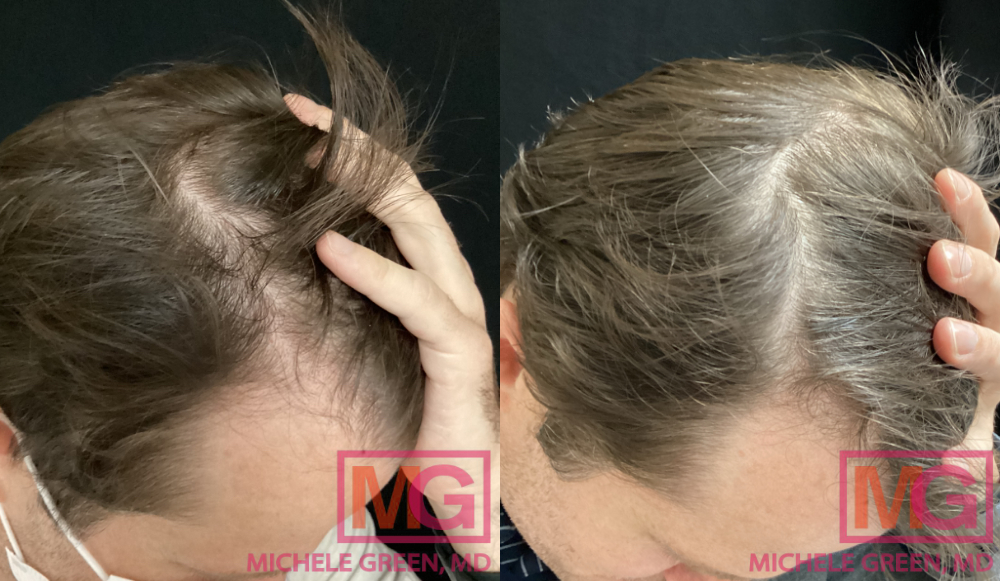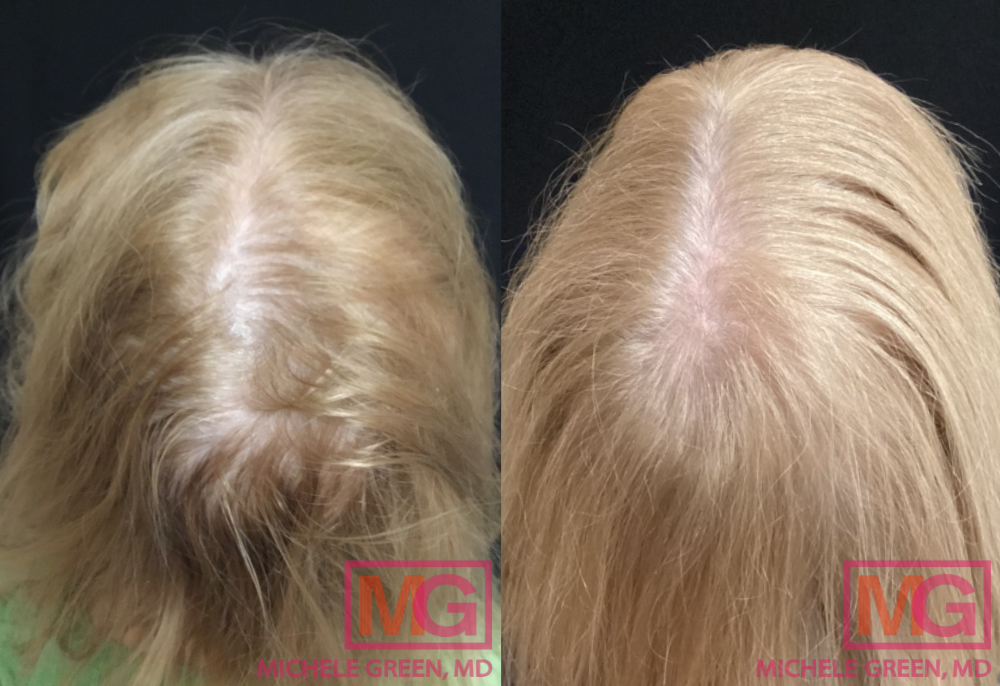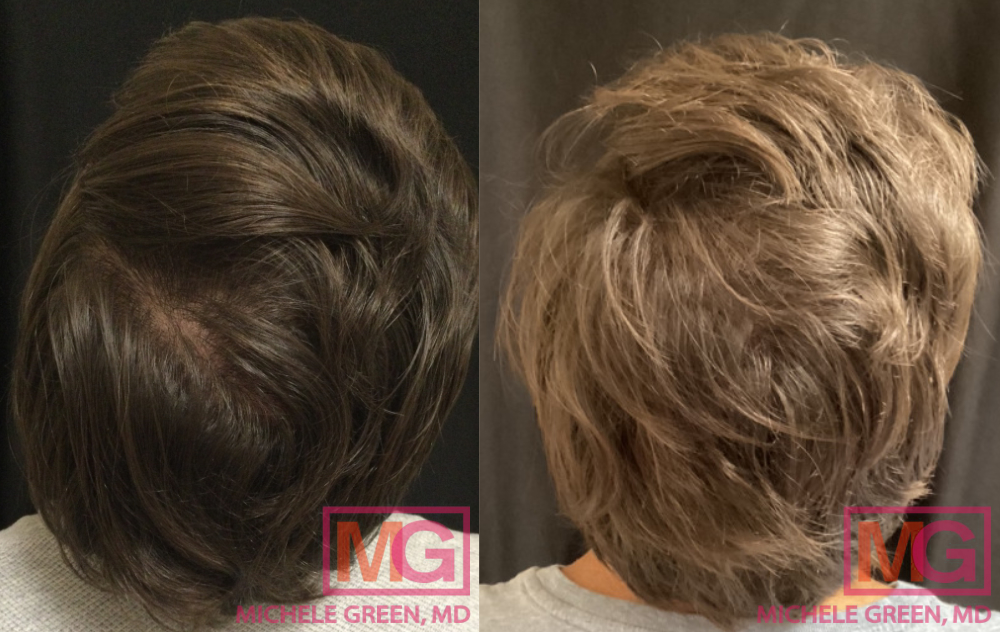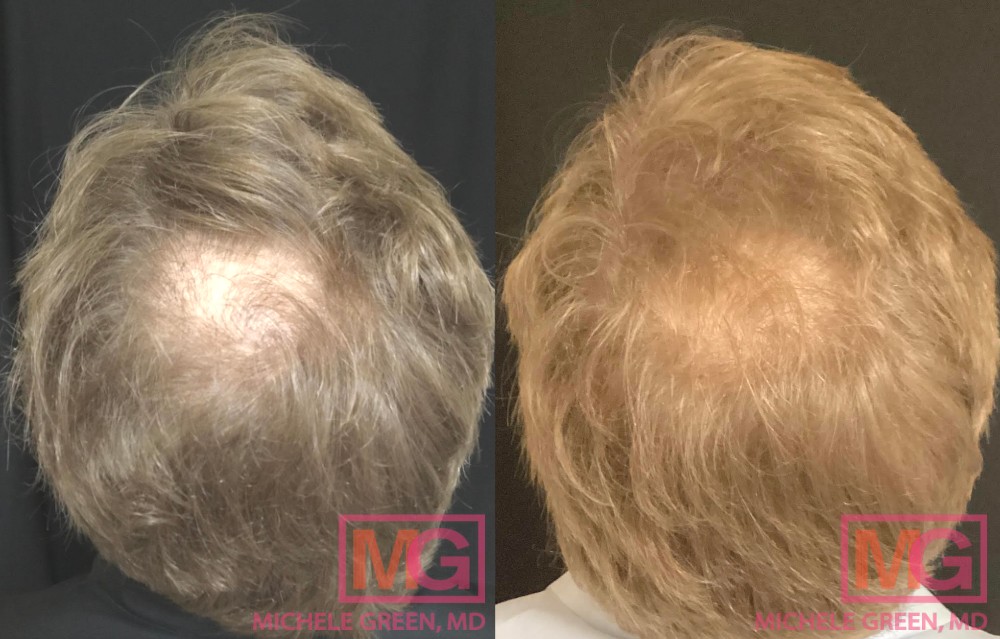PRP Injections for Hair Regrowth
Hair loss and thinning hair are common conditions that affect as many as 50 million men and 30 million women in their lifetime. Hair loss can occur for many reasons, ranging from genetic conditions like androgenetic alopecia (also known as androgenic alopecia, male pattern baldness, or female pattern baldness), autoimmune disorders like alopecia areata, acute stressful events like telogen effluvium, medications, or hormone fluctuations. Regardless of the cause of hair loss, noticing a decrease in hair thickness and hair density on various areas of the scalp can be extremely distressing for patients, leading to low self-esteem and symptoms of depression. With many treatment options on the market – with varying levels of effectiveness – it can be difficult to determine how best to treat and prevent hair loss. That is why the best first step for developing a hair loss treatment plan is to seek out an expert board-certified dermatologist, such as Dr. Michele Green, who can recommend the best treatment option for hair rejuvenation. Often, Dr. Green will turn to platelet-rich plasma injections for new hair growth.
Platelet-rich plasma therapy — also known as PRP therapy — uses the growth factors found in the patient’s blood to heal hair follicles, improve hair density, and trigger new hair growth. Often used medically for wound healing, skin rejuvenation, and addressing musculoskeletal injuries, platelet-rich plasma (PRP) treatment is now being used to address hair loss and hair thinning conditions, such as androgenetic alopecia and alopecia areata. While it has not yet been FDA-approved for hair loss treatment, the effects of platelet-rich plasma on hair regrowth have been tested in clinical trials, demonstrating promising results. PRP can also be paired with other hair loss treatments to improve the overall results, including medications such as finasteride, minoxidil, and Microneedling. With a low risk of side effects and demonstrably positive results, PRP injections have become an excellent treatment option for patients concerned with hair loss.
Experienced board-certified dermatologist Dr. Michele Green has been expertly treating patients in her Upper East Side New York City dermatology office for more than 25 years. An expert in a wide range of medical and cosmetic procedures, Dr. Green has been praised by many patients for her proficiency in such treatments as Botox injections, dermal fillers, laser therapy, Microneedling, and much more. Known for her high patient satisfaction, Dr. Green has been voted one of the best healthcare providers in New York City by such publications as Castle Connolly, New York Magazine, and Super Doctors.
What is platelet-rich plasma treatment (PRP treatment)?
PRP treatment utilizes autologous plasma—meaning plasma drawn from the patient’s own blood—placed in a centrifuge to separate the high-platelet-count plasma from the red blood cells. When injected into the treatment area, PRP therapy helps to promote healing, assist with blood clotting, decrease inflammation, and strengthen the growth of new cells. Due to the use of the patient’s own blood, the risk of experiencing an allergic reaction to PRP treatment is very low, making it a safe and effective treatment option for a variety of conditions and medical concerns, including skin rejuvenation, post-surgical or musculoskeletal healing, and hair loss.

Why does hair loss occur?
Hair loss can occur for a wide variety of reasons, including genetic predisposition, hormone fluctuation, acute stress or injury, medications, or autoimmune disorders. One of the most common types of hair loss is androgenic alopecia, known colloquially as male-pattern hair loss or female-pattern hair loss. The exact underlying cause of androgenetic alopecia is unknown, but it is related to high concentrations of androgen hormones. With higher levels of the androgen hormone, the hair growth cycle becomes shorter, and the hair follicles become more damaged over time. In men, androgenic alopecia is characterized by a receding hairline along the temples that forms an “M” shape, followed by balding on the crown of the head. Often, this hair thinning occurs all over the crown of the head, resulting in hair only in a “U” shape around the sides and back of the head. Androgenetic alopecia can also affect women but typically manifests differently. Hair thinning typically begins on the crown of the head, creating a widening of the center part.
No matter the cause, thinning hair can be very distressing for patients, causing them to seek out treatment options. When determining your treatment plan, your dermatologist needs to discover the underlying cause of your hair loss to prescribe the proper care. When it comes to treating androgenetic alopecia, Dr. Green will often turn to platelet-rich plasma therapy.
How does PRP therapy work for hair loss treatment?
Platelet-rich plasma therapy is a highly effective treatment for patients experiencing hair thinning or hair loss due to conditions such as androgenetic alopecia and even alopecia areata (a type of alopecia triggered by an autoimmune disorder). When injected into the scalp, the high concentration of platelets helps to activate growth factors at and around the injection site, improving circulation in the treatment area and triggering the healing of damaged hair follicles. As a result, PRP therapy can strengthen the hair follicles in the treatment area and thicken the hair shaft, leading to higher hair density. Additionally, as damaged hair follicles heal, the number of hairs increases as well, as inactive hair follicles become reactivated. PRP therapy can be used on its own or in combination with other treatment options, such as finasteride, minoxidil, hair transplant, and Microneedling.
Does PRP regrow hair?
PRP treatment can help to regrow hair and prevent future hair loss and hair thinning in patients with androgenic alopecia. Hair growth occurs in three phases: the growth phase (anagen phase), the resting phase (telogen phase), and the shedding phase. Typically, hair growth lasts for 2-6 years before moving into the resting phase and eventually shedding, which is a very natural process. However, some hair loss conditions, such as androgenic alopecia, cause the hair growth phase to shorten significantly and for new hair growth to be shorter and thinner. PRP injections help to regrow hair by lengthening the hair-growing phase and strengthening the hair follicle, resulting in thicker hair shafts, higher hair density, and healthier hair follicles.

How to inject PRP for hair regrowth
The first step in PRP treatment is to schedule an initial consultation with an expert board-certified dermatologist, such as Dr. Michele Green, to determine the underlying cause of your hair loss. Once Dr. Green has examined the treatment area and determined the cause of the hair loss, she will generate the treatment plan that will be most effective for you. If PRP is the best option, the PRP treatment process begins with a blood draw, where a patient’s blood is placed in a centrifuge to separate the blood into three layers: red blood cells, platelet-poor plasma, and platelet-rich plasma. Before injecting the high concentration of platelet-rich plasma into the treatment site, Dr. Green will apply topical anesthesia approximately one hour before the injections to limit any potential discomfort that the injections might cause. The injections themselves are quick to perform, and the whole treatment process generally takes less than 30 minutes. There is no downtime necessary following the treatment, meaning that patients can immediately return to their regularly scheduled activities.
What are the side effects of PRP injections for hair restoration?
PRP therapy is a low-risk procedure that is not typically associated with any severe side effects. Because the treatment uses the patient’s blood and plasma, there is almost no risk of an allergic reaction. When seeking treatment from an experienced dermatologist, such as Dr. Green, the risk of side effects is quite low. But if you seek treatment from a less experienced injector, the potential side effects of the treatment are as follows:
- Damage to blood vessels on the scalp area.
- Injury to nerves
- Infection at the injection site
When does PRP for hair start working?
For optimal results, Dr. Green typically recommends that patients schedule 2-3 treatment sessions spaced approximately 4-6 weeks apart. Patients will begin to see the treatment results within a few weeks of receiving the injections. In some cases, Dr. Green may have a patient schedule three initial appointments and then a touch-up every three months for the first year of treatment. After that, patients will likely only need a touch-up once a year.
How long does it take for PRP to regrow hair?
PRP treatment helps to boost the body’s natural healing processes to promote hair regrowth and to strengthen the hair follicles at the injection site for thicker, denser, new hair growth. As such, it usually takes a couple of weeks for the results to become visible, and the full results of the treatment are often seen three to six months post-injections. To maintain the treatment results, Dr. Green recommends scheduling a touch-up appointment once a year following the initial round of treatment sessions.

How effective is PRP for hair growth?
Patients often wonder, “How effective is PRP for hair regrowth?” The effectiveness of PRP therapy on hair growth is still being studied. Still, researchers have already found that the treatment helps to prevent hair loss and hair thinning and promotes new hair growth in patients with androgenetic alopecia. In a review of clinical trials measuring the effectiveness of PRP on combatting male pattern hair loss, researchers found that PRP injections helped to significantly increase the number of hairs, the thickness of hair follicles, and hair density compared to the control group. Furthermore, when comparing the effects of PRP treatment on hair loss, studies have found that compared to other treatment options (finasteride, minoxidil, and stem-cell solutions), 84% of patients who received PRP injections reported experiencing a positive change, and 50% of patients reported a significant decrease in hair thinning and hair loss. As such, many studies have already demonstrated the effectiveness of PRP for hair growth.
How successful is PRP for hair growth?
PRP treatment is a safe and effective treatment for hair growth and hair loss prevention. One of the major benefits of the treatment is that it is a non-surgical procedure, meaning no plastic surgery or hair transplants are required to see the positive results of the treatment. The risk of significant side effects and allergic reactions to the treatment is very low, and there is no downtime associated with treatment, making it highly accessible for most patients. Unlike other methods of stopping hair loss, PRP does not have the same unpleasant side effects associated with topical treatment options like Rogaine or oral medications. In that way, PRP is very successful in treating hair growth without side effects or downtime.
Does PRP regrow hair permanently?
PRP is a long-lasting treatment option for hair regrowth, but it is not a permanent solution. The longevity of the treatment varies from person to person, often depending on the severity of the hair loss condition and the concentration of platelets in the patient’s plasma. However, the treatment results can last for up to 18 months. Dr. Green typically recommends that patients schedule touch-up appointments to maintain the treatment results.
How much do PRP hair injections cost?
The cost of PRP Injections depends on a number of factors, including the scope of the treatment area, your geographic region, the type of institution at which you receive treatment, and whether PRP therapy is combined with other treatment options. While institutions such as Medical Spas may have deals or specials that bring the cost of treatment down, the risk of developing serious side effects is much higher at these institutions. That is why it is always best to seek treatment from an expert board-certified dermatologist, such as Dr. Green. After your initial consultation, when Dr. Green examines the treatment area, determines the cause of hair loss, and generates a treatment plan, her office can provide you with a clearer estimate of the total cost of the treatment.
Is there any other injection for hair growth?
Most other hair regrowth treatment options are topical treatments or oral medications. Studies have shown that the most effective treatment plan involves a combination approach involving PRP injections and medications such as minoxidil or finasteride. During your initial consultation with Dr. Green, she will determine the treatment or combination of treatments that will best meet your needs.
Can PRP regrow hair on a bald head?
While PRP injections do help to promote new hair growth, they are not effective at triggering hair regrowth on a completely bald head. PRP cannot trigger hair growth if the hair follicle no longer exists—it has to be dormant at most. There are still treatment options for patients who have lost their hair completely, including a hair transplant, and PRP treatment can help to promote hair growth following the transplant.
Do PRP injections work for hair growth?
Patients often ask, “Does PRP treatment regrow hair?” and the answer is yes! PRP injections are a safe and effective treatment option for preventing hair loss, healing damaged hair follicles, and thickening the hair shaft for denser hair and new hair growth. Several researchers have already started studying the effectiveness of PRP injections on hair regrowth, demonstrating that PRP injections have a significant impact on new hair growth in patients with androgenic alopecia. To find out if PRP injections are right for you, schedule your initial consultation with Dr. Green.

How to get started with PRP injections for hair regrowth today
Hair loss and hair thinning are common conditions that affect millions of men and women throughout their lifetimes. As hair is often a major part of one’s identity, the loss of hair can be very distressing. While there are many hair loss treatment options available, it is difficult to tell which are effective and what to try. The best first step is to consult with an expert dermatologist, such as Dr. Michele Green, who will examine the treatment area to determine the root cause of the hair loss. Some patients, such as those with androgenic alopecia (male/female pattern baldness), may benefit from PRP injections for new hair growth. PRP injections are highly effective at thickening the hair shaft, healing damaged follicles, and lengthening the hair growth phase for denser, thicker hair. Schedule your appointment with Dr. Green to get started with long-lasting hair regrowth solutions.
Dr. Michele Green is an internationally renowned board-certified dermatologist with over two and a half decades of experience providing her patients with the best non-invasive treatment options. Dr. Green takes a holistic approach and embraces a less-is-more philosophy, creating customized skincare routines and treatment plans that cater to the unique concerns and aesthetic goals of her patients. She is consistently identified as one of New York’s best dermatologists by Castle Connolly, New York Magazine, and Super Doctors for her dedication to her patients and expertise. Please call us at 212-535-3088 or email our New York City-based office today to schedule a consultation with Dr. Michele Green to find out if PRP injections are right for you.
 212-535-3088
212-535-3088